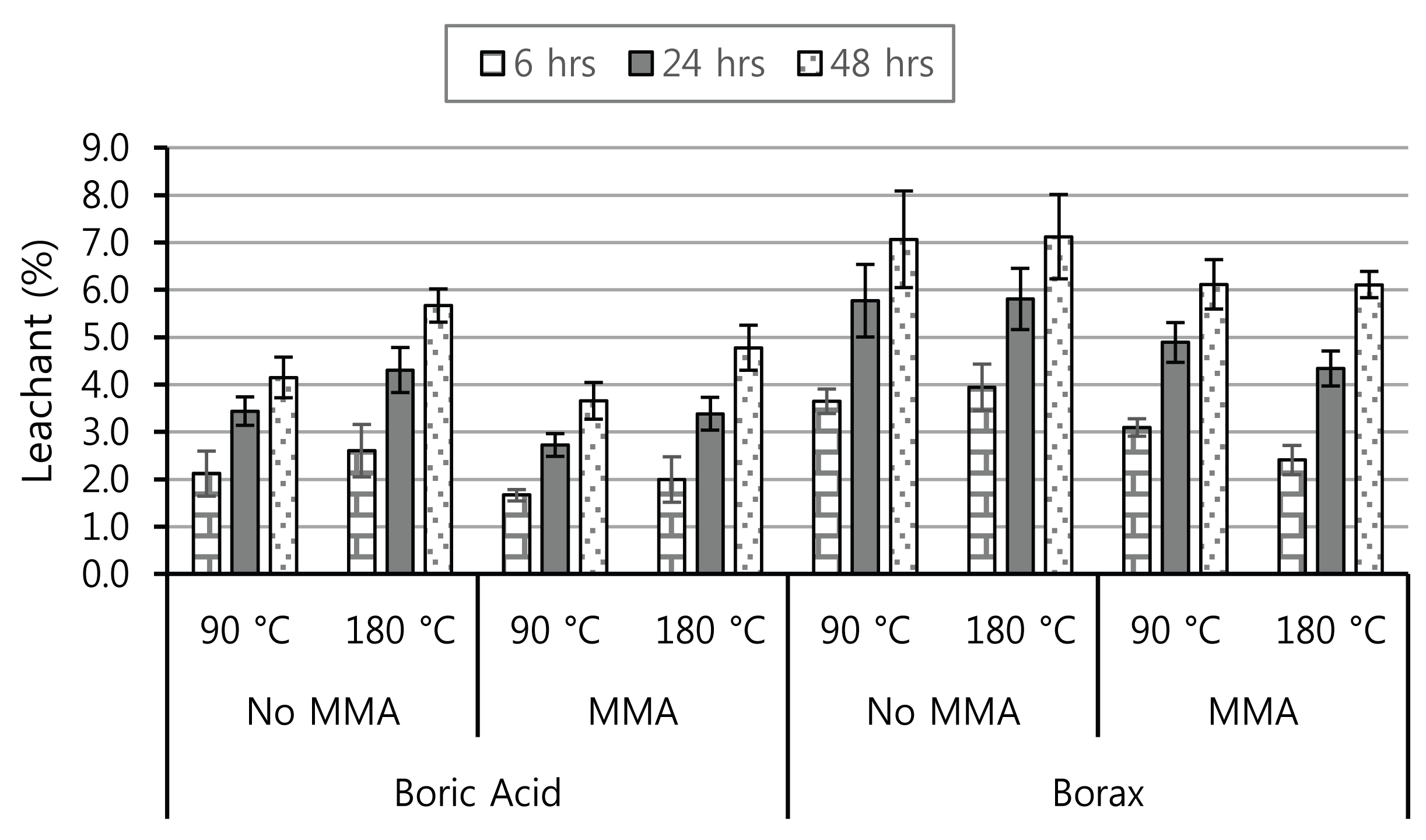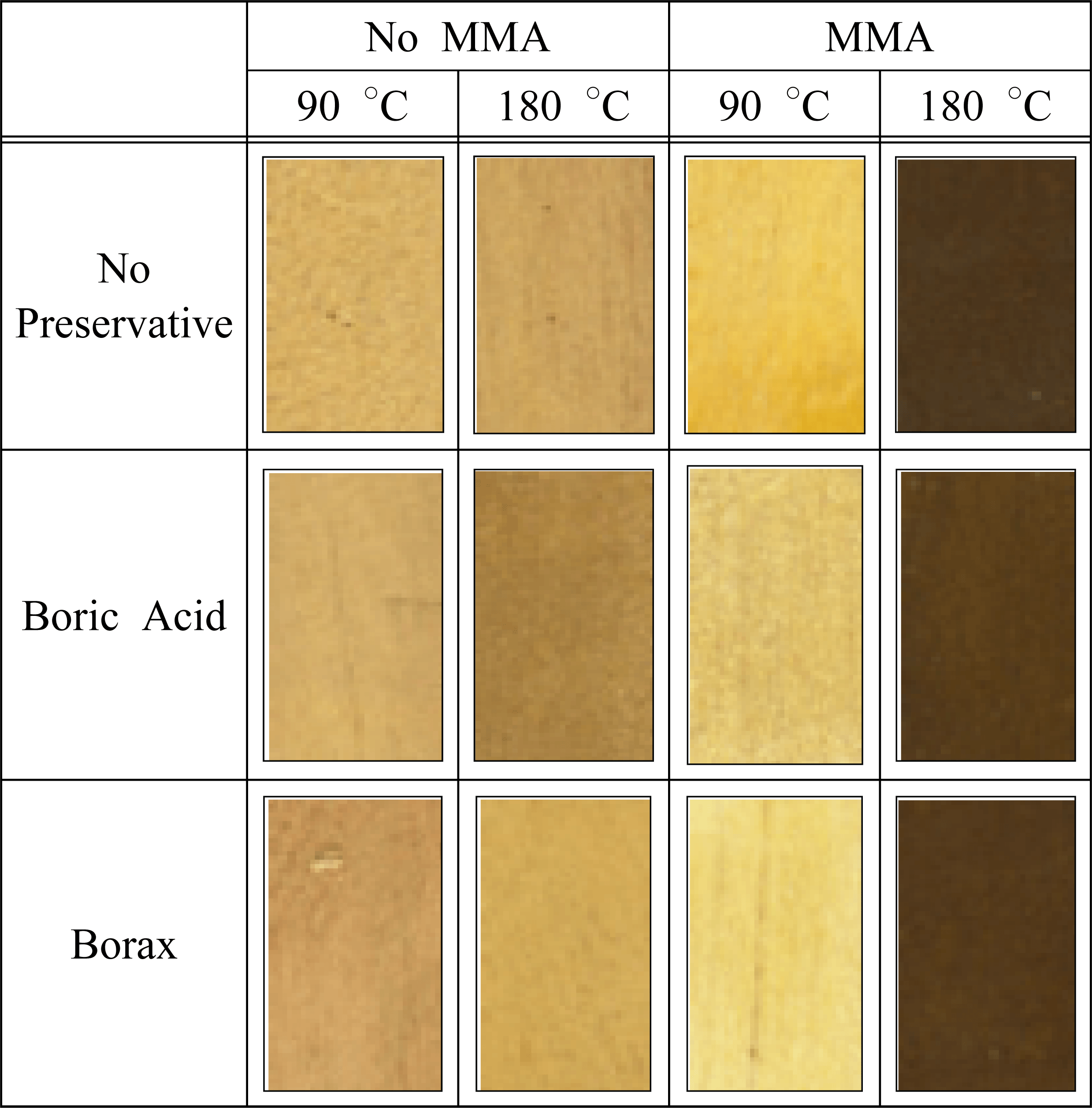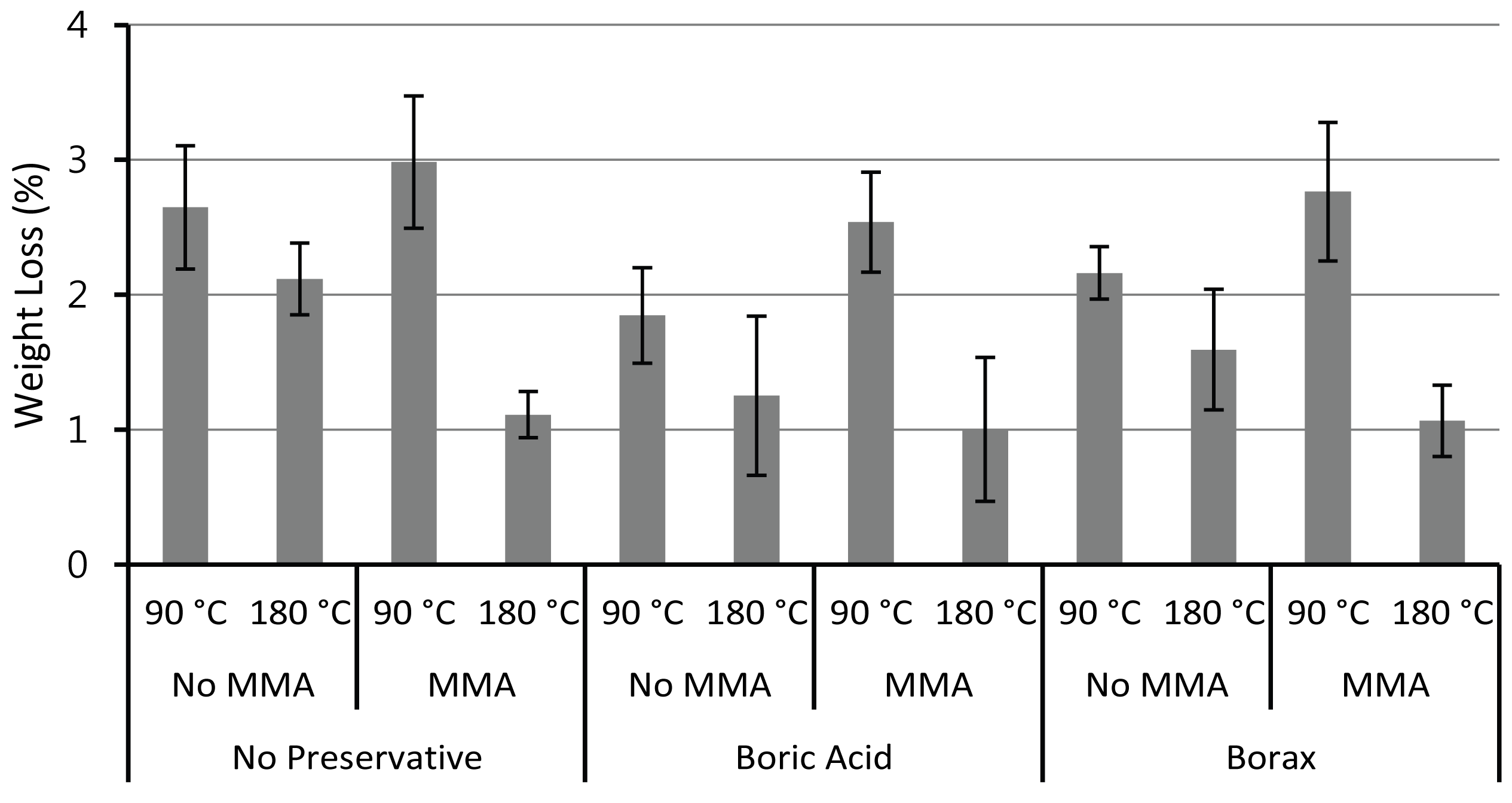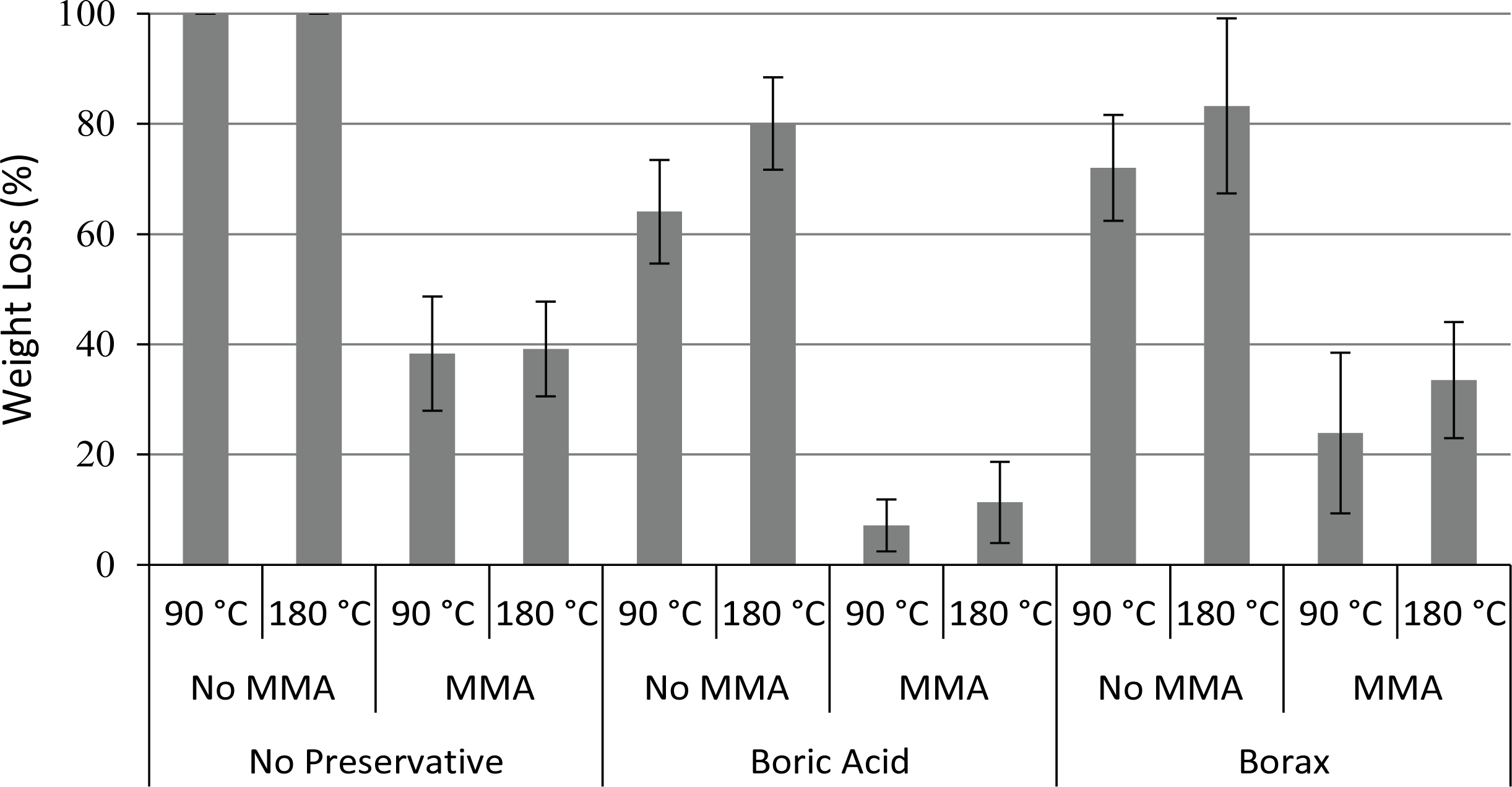1. INTRODUCTION
Red jabon (Anthocephalus macrophyllus) was a fast-growing hardwood with specific gravity and density of 0.48 and 0.45 g/cm3 respectively (Lempang, 2014; Cahyono et al., 2015). This wood had a cylindrical trunk, high branch-free area, and good veneer quality (Cahyono et al., 2016). Red jabon wood according to Indonesian National Standard (known as Standar Nasional Indonesia/SNI) had strength class III (Cahyono et al., 2012) and durability class IV (Halawane, 2015). Therefore, quality improvement of red jabon wood was needed especially in the resistance to wood destroying organisms. The quality of wood could be improved with wood modification, such as chemical impregnation and heat treatment.
Impregnation of wood preservative in a pressure tank had been a commercial method in producing durable wood (Hadi et al., 2018). Boric acid and borax were boron preservatives commonly used in wood preservation (Salman et al., 2014; Jebrane and Heinmaa, 2016). Boron compounds were good efficacy-preservative for protecting wood from fungi and insects (Kartal et al., 2019). However, the main problem of boron preservative was prone to leaching in a wet environment (Lesar et al., 2009). Various manipulations had been made to reduce this weaknesses, one of them was by adding the bulking agent. Methyl methacrylate (MMA) was bulking agent material and might be used to improve wood properties (Yalinkilic et al., 1998; Ding et al., 2011). MMA was a colorless and volatile liquid (Dormer et al., 1998) that could improve the physical and mechanical properties of wood (Hadi et al., 2013; Cahyono et al., 2020).
Heat treatment was an environmentally friendly technique for wood quality improvement (Aydemir et al., 2011; Sandberg et al., 2017; Priadi et al., 2019). The temperature of wood heat treatment was generally above 100 °C, or between 150-230 °C (Coto et al., 2015; Romagnoli et al., 2015). Heat treatment could improve the dimensional stability of wood (Lee and Lee, 2018; Priadi et al., 2019), its resistance to decay fungi (Kim et al., 2018; Park et al., 2018) and reduce wood hygroscopicity (Tomak et al., 2011; Chang et al., 2019).
The objective of this research was to evaluate the dimensional stability, color chage and durability of modified red jabon wood by double impregnation with boron and methyl methacrylate (MMA) and heat treatment.
2. MATERIALS and METHODS
Red jabon (Anthocephalus macrophyllus Roxb. Havil) boards were cut from a 9-year-old tree, 3 trunks that had an average diameter at breast height of 40 cm. The woods were taken from the community forest in Bogor, Indonesia and highly selected to obtain the flawless trunks. The test sample was a board taken from a wood part with the distance of 50 cm above the ground and 8 cm from the wood pith. The boards were dried in an experimental drying kiln at 40 °C to gain moisture content of 10%. Then the boards were turned into different test samples. The sample size for dimensional stability, color, leaching, laboratory and field decay tests were 2.5 × 2.5 × 10 cm3, 2.5 × 2.5 × 5 cm3, 2 × 2 × 1 cm3, 2.5 × 2.5 × 5 cm3 and 2 × 2 × 37 cm3 respectively. Each test used five replication of samples.
Boric acid, borax and methyl methacrylate (MMA) were used as impregnants. Boric acid and borax solutions were made at 5% concentration each for impregnation I. MEPOXE M (Methyl Ethyl Ketone Peroxide) was used as the catalyst for curing MMA, which was mixed at ratio 1:10 before impregnation II.
The impregnation treatment were in two stages then followed by heat treatments at temperatures of 90 °C or 180 °C for 4 hours, as described in Table 1. The impregnation was conducted in pressure wood treatment equipment at 5 atmospheric pressure for 4 hours. Before the impregnation II, the samples were oven-dried at 103±2 °C. Heat treatments were conducted after impregnation II at temperatures of 90 °C or 180 °C for 4 hours in an electrical heating oven. The total amount of time required for the process of impregnation I, II and heat treatment was three days.
Dimensional stability, water absorption and leaching tests were done by soaking wood samples in water for 2, 24 and 48 hours. Each soaking was followed by oven drying at 103±2 °C to a constant weight. Dimensional measurements were made before and after soaking using digital caliper. Weighing the samples were carried out before and after water soaking in both wet and dry conditions. Then the volumetric swelling from air dry to wet conditions were determined using Equation 1. The anti-swelling efficiency (ASE) was calculated with Equation 2. Dimensional shrinkage of wood in both tangential and radial directions were determined from wet to dry condition using Equation 3. The tangential-radial shrinkage ratio was calculated using Equation 4, while water absorption and leachant were calculated using Equations 5 and 6 respectively.
Where:
S = Swelling (%)
Vi = Volume before soaking (cm3)
Vw = Volume after soaking (cm3)
ASE = Anti swelling efficiency (%)
Sc = Swelling of untreated sample (%)
St = Swelling of treated sample (%)
SH = Shrinkage (%)
Dw = Dimension (tangential, radial) before oven drying (cm)
Do = Dimension (tangential, radial) after oven drying (cm)
T/R = Ratio of tangential-radial shrinkage
SHt = Tangential shrinkage (%)
SHr = Radial shrinkage (%)
WA = Water absorption (%)
Woi = Oven dry weight before soaking (g)
Wwf = Wet weight after soaking (g)
L = Leachant (%)
Wof = Oven dry weight after soaking (g)
Wood color evaluation began with scanning of a wood surface with CanoScan 4400F scanner (color dpi resolution of 4800 × 9600). Then ImageJ program was used to determine L*a*b* values before and after treatments at the same three positions on the wood surface image. In the CIELab system, the value L* was a lightness parameter with values 0 (black) to 100 (white). The a* chromatic value represents red (+) to green (-), while b* chromatic value represents yellow (+) to blue (-) (Christie, 2014). The color change (ΔE*) of wood was calculated based on Equation 7 and classified as negligible (0-0.5), slightly perceivable (0.5-1.5), noticeable (1.5-3.0), appreciable (3.0-6.0), very appreciable (6.0-12.0), and totally changed (more than 12.0) (Cui et al., 2007, Hidayat et al., 2017).
Where:
ΔE* = Color change
ΔL* = L*after – L*before treatment
Δa* = a*after – a*before treatment
Δb* = b*after – b*before treatment
The resistance of wood to decay fungi was tested based on SNI 7207: 2014 standard (BSN, 2014) with a slight modification, after determining oven dry weight, the samples were wetted to facilitate fungal growth by dipping shortly in sterile water. The wood samples were oven dried at 103±2 °C until a constant weight. Furthermore in a laminar air flow, wood sample was put into a petri dish where decay fungi, Schizophyllum commune has been grown and covered potato dextrose agar (PDA) medium. After 12 weeks incubation at room temperature, the wood sample was cleaned and oven dried at 103±2 °C until a constant weight to determine weight loss due to fungal attack using Equation 8.
The field test of wood resistance to termite was conducted at the Arboretum of Faculty of Forestry, IPB University. Test samples were oven dried at 103±2 °C to a constant weight. According to ASTM D 1758-06 standard (ASTM, 2006), the sample was exposed in ground contact and buried up to 2/3 of its length. The row and lane spacing between samples were 30 cm and 60 cm respectively. The sample placement points in the field were marked and then the samples were placed randomly on those marked points. After three months exposure, the samples were cleaned and oven dried at 103±2 °C to a constant weight. The weight loss of wood sample was determined by Equation 8.
Where:
WL = Weight loss (%)
Wi = Dry weight of sample before test (g)
Wt = Dry weight of sample after test (g)
The effects of impregnation and heating on the dimensional stablity, color change and durability of red jabon wood were analyzed statistically using a completely randomized factorial design. The experiment design included three variable factors of treatment with five replications. The factors were preservative (no preservative, boric acid and borax), monomer (no MMA and MMA), and heating temperature (90 °C and 180 °C). Analysis of variance was followed by Duncan test when there was a significant effect at the 95% confidence level. The data were processed using Microsoft Excel 2013 and IBM SPSS Statistic 22.0.
3. RESULTS and DISCUSSION
According to Williams and Amburgey (1987), wood preservation with boron cannot be used in ground contact due to boron susceptible to leaching. Therefore, the use of boron preservative requires a leaching test to assess the stability of boron in wood. This research revealed that leachant in impregnated red jabon wood with borax was significantly higher than that of impregnated red jabon wood with boric acid, which means that borax preservative was more prone to leaching than boric acid. However, the use of MMA significantly reduced leaching of boron preservatives (borax and boric acid) in red jabon wood (Fig. 1). This could be caused by bulking agent effect of MMA in wood that inhibited the movement of boron compounds that had been previously impregnated into the wood. As the report of Hadi et al. (2013) that MMA entered cavities in wood experiences polymerization after heating and made wood denser. In addition according to Muberra (2016), a trans-esterification reaction could occur between polymethyl methacrylate to an aromatic boron compound.
Impregnation and heat treatment changed the water absorption of red jabon wood (Fig. 2). Analysis of variance and Duncan test revealed that water absorption of red jabon wood reduced significantly by boron (borax and boric acid) preservation and MMA impregnation (Table 2). The water absorption was also reduced by heat treatment at 180 °C. This result was in accordance with Kartal et al. (2007) that water absorption of heatmodified wood decreases with increasing temperature and heating time. Li et al. (2011) also reported that wood moisture content reduced by high temperature heating.
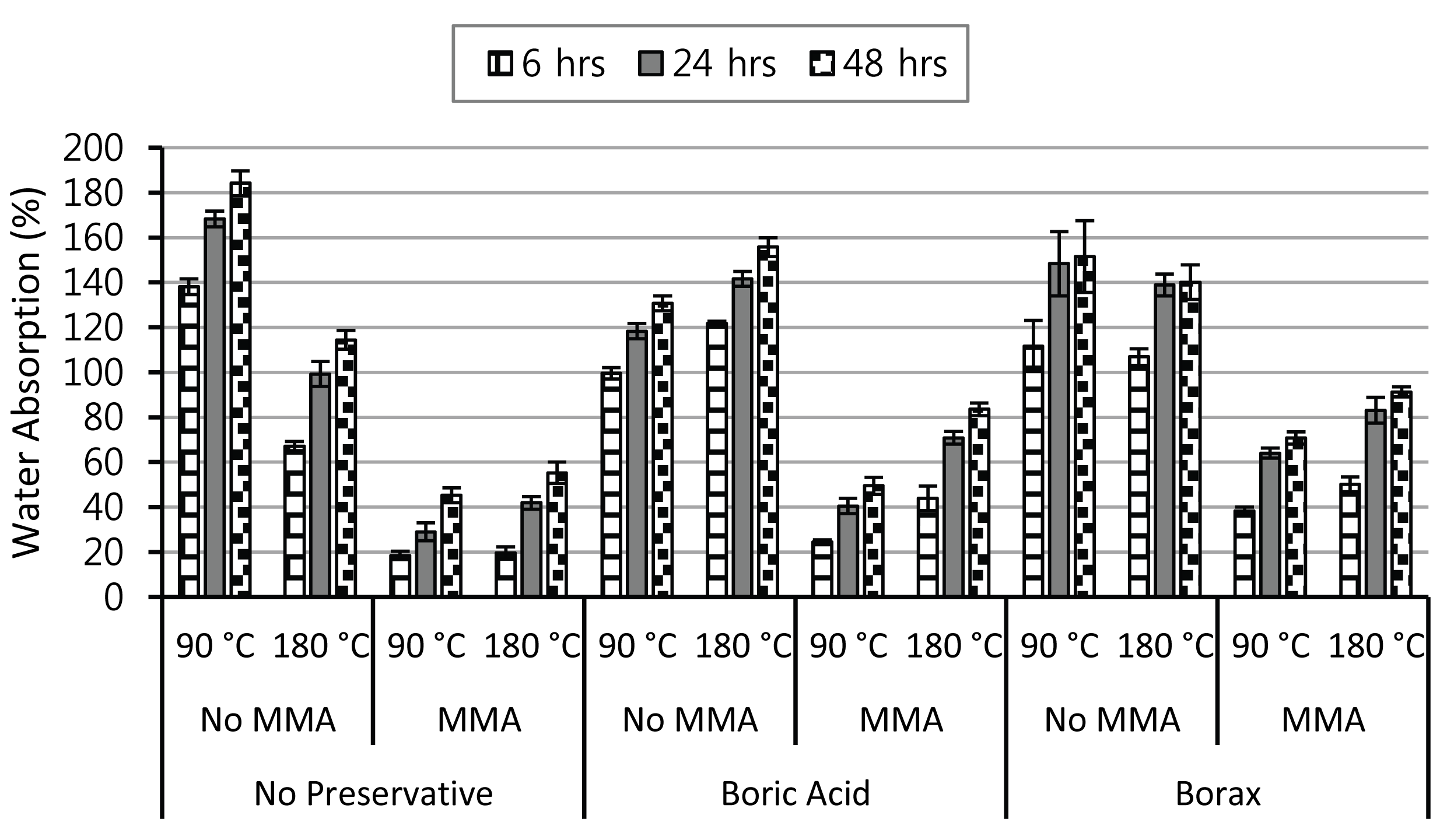
The lowest water absorption in this research was achieved by MMA impregnation with heating at 90 °C. This corresponds to Hadi et al. (2013) that MMA treatment could reduce wood moisture content because of the formation of hydrophobic material in wood. A very low water absorption of red jabon wood was also achieved by boric acid and MMA impregnation followed by heating at 90 °C.
Dimensional stability was an important property of wood influenced by environmental conditions, especially temperature and humidity. Wood dimensional stability was evaluated based on anti-swelling efficiency (ASE). Fig. 3 showed that heat treated red jabon wood had positive ASE value, meaning its dimensional stability increased. In general, heating at 180 °C resulted higher ASE value of the wood than heating at 90 °C. This was consistent with Bekhta and Niemz (2003) that heated wood was more stable with increasing temperature and heating time. Kocaefe et al. (2008) also reported that heat treatment at 130 °C could modify the hydrophilic polymer of the wood that became more hydrophobic and improved wood dimensional stability.
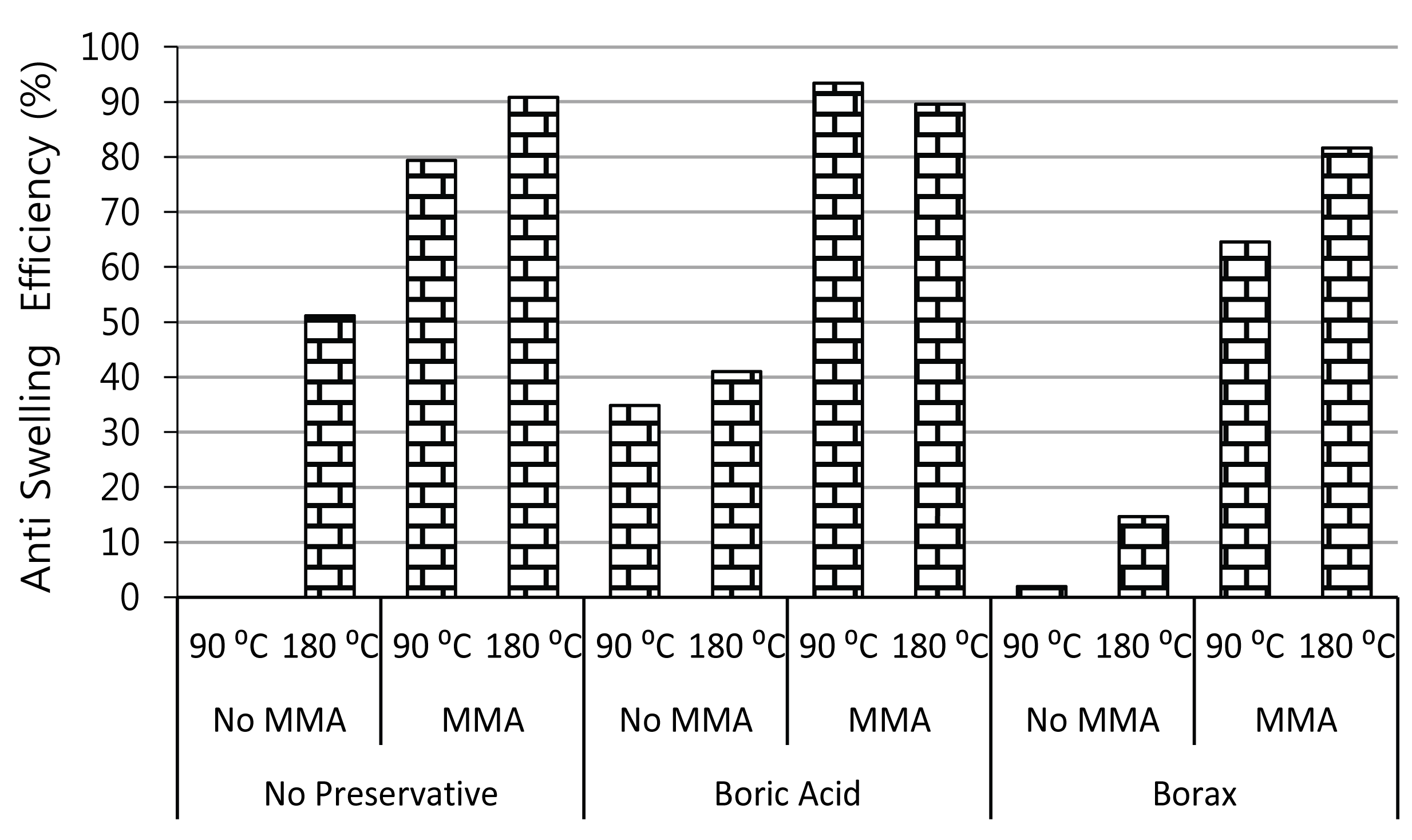
ASE of red jabon wood increased after MMA impregnation, which might be caused by water inhibition by MMA polymer in wood. As Koubaa et al. (2012) reported that MMA impregnation filled voids in wood structures of fast-growing poplar clones. This was in accordance with Ding et al. (2011) that MMA impregnation could increase the density and dimensional stability of wood.
Boron impregnation affected the tangential-radial shrinkage ratio (T/R ratio) of red jabon wood. The T/R ratio of wood impregnated with boric acid was lower than the wood impregnated with borax (Fig. 4). This meant that boric acid impregnation resulted better dimensional stability of wood than borax impregnation. T/R ratio closing to 1 showed better dimensional stability of wood, while Bowyer et al. (2007) stated that T/R ratio exceeding 2 indicated worse wood dimensional stability. MMA impregnation resulted in a lower T/R ratio compared to untreated red jabon wood. According to Hadi et al. (2013) MMA treatment had a bulking effect in wood shrinkage. In this research, the bulking effect showed to be a slight more in tangential direction than in radial direction of red jabon wood.
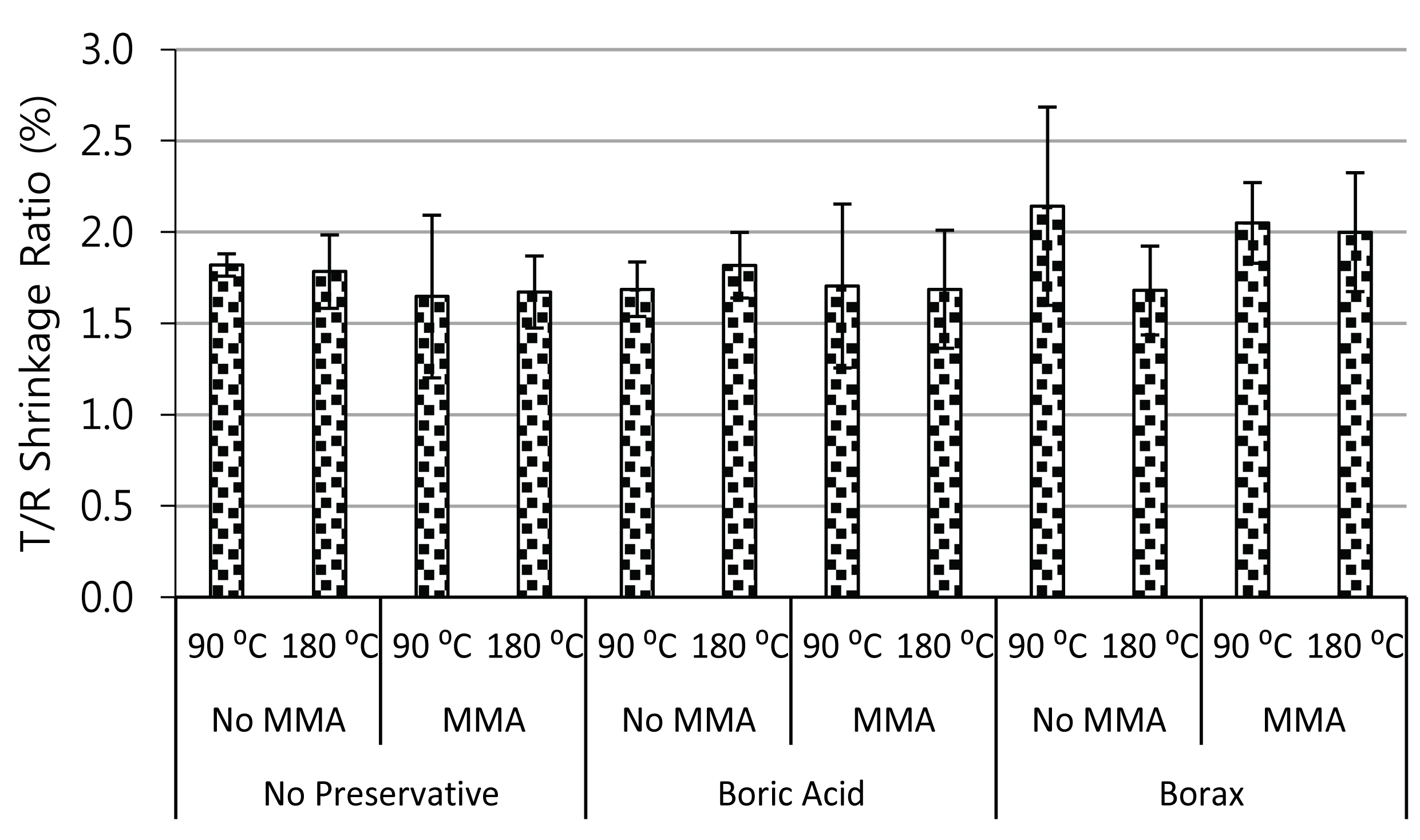
Impregnation and heat treatment changed the color of red jabon wood. The color change mainly occurred after MMA treatment, while boric acid and borax preservatives did not cause color change significantly. Different heating temperatures also affected the color of wood (Fig. 5). This supported Hill (2007) that the color change of wood was affected by the temperature and time of heating. Heat treatment at 180 °C decreased brightness value (L*) of red jabon wood, mainly those previously impregnated with MMA (Fig. 6). The reddish value (a*) of modified red jabon wood was relatively unchanged, except a slight decrease of a* after impregnation of borax and heating 90 °C. The yellowish value (b*) was not clearly affected by boron preservation. The b* value of MMA impregnated red jabon wood increased by heating at 90 °C, but decreased by heating at 180 °C.
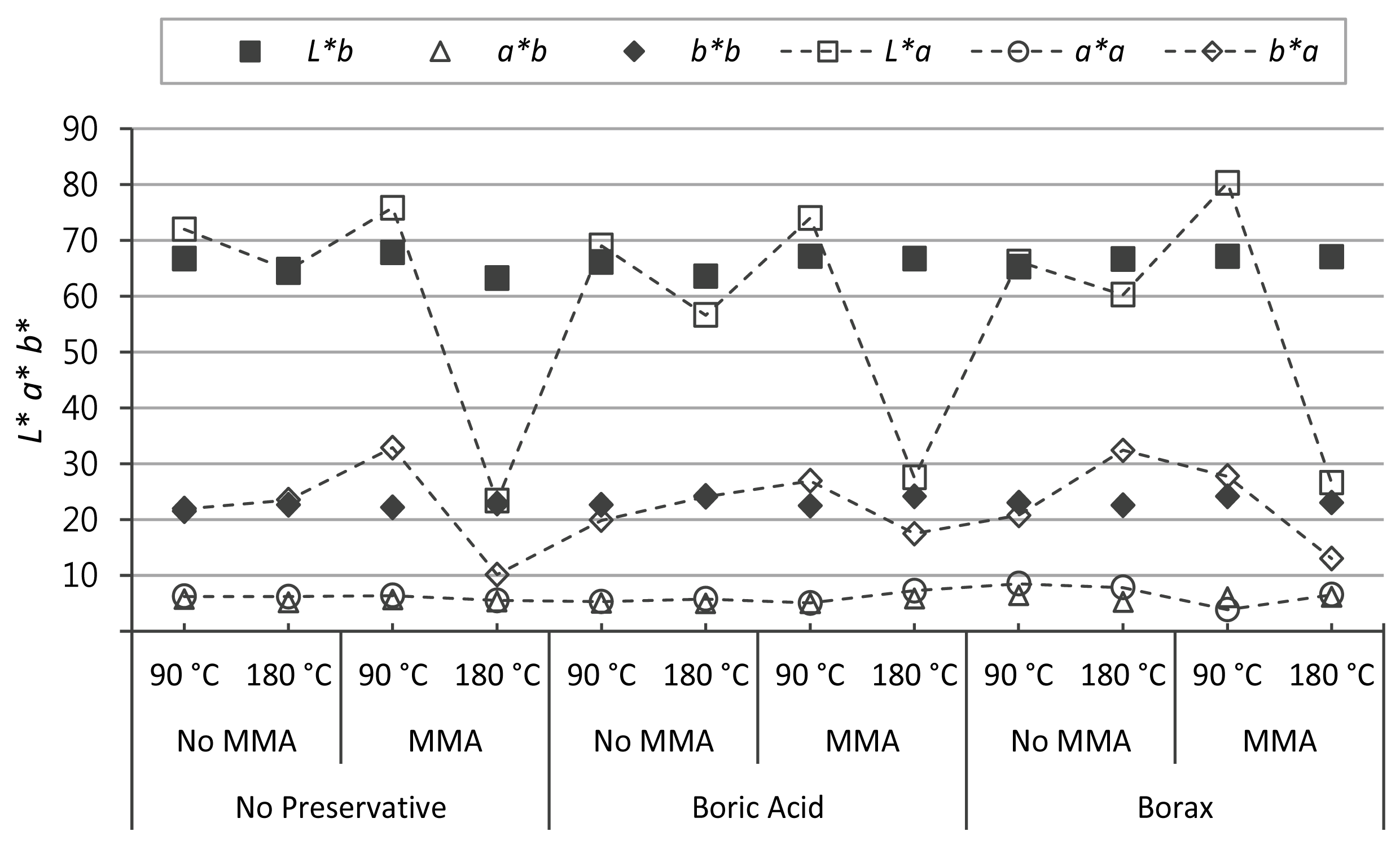
The color change value (ΔE*) of red jabon wood occurred significantly after MMA impregnation, especially those heated at temperatures of 180 °C (Fig. 7). Preservation with boric acid and borax caused only a slight increase in the ΔE* value of red jabon wood, while heating at 180 °C on borax treated wood resulted in higher ΔE* value than that on boric acid treated wood.
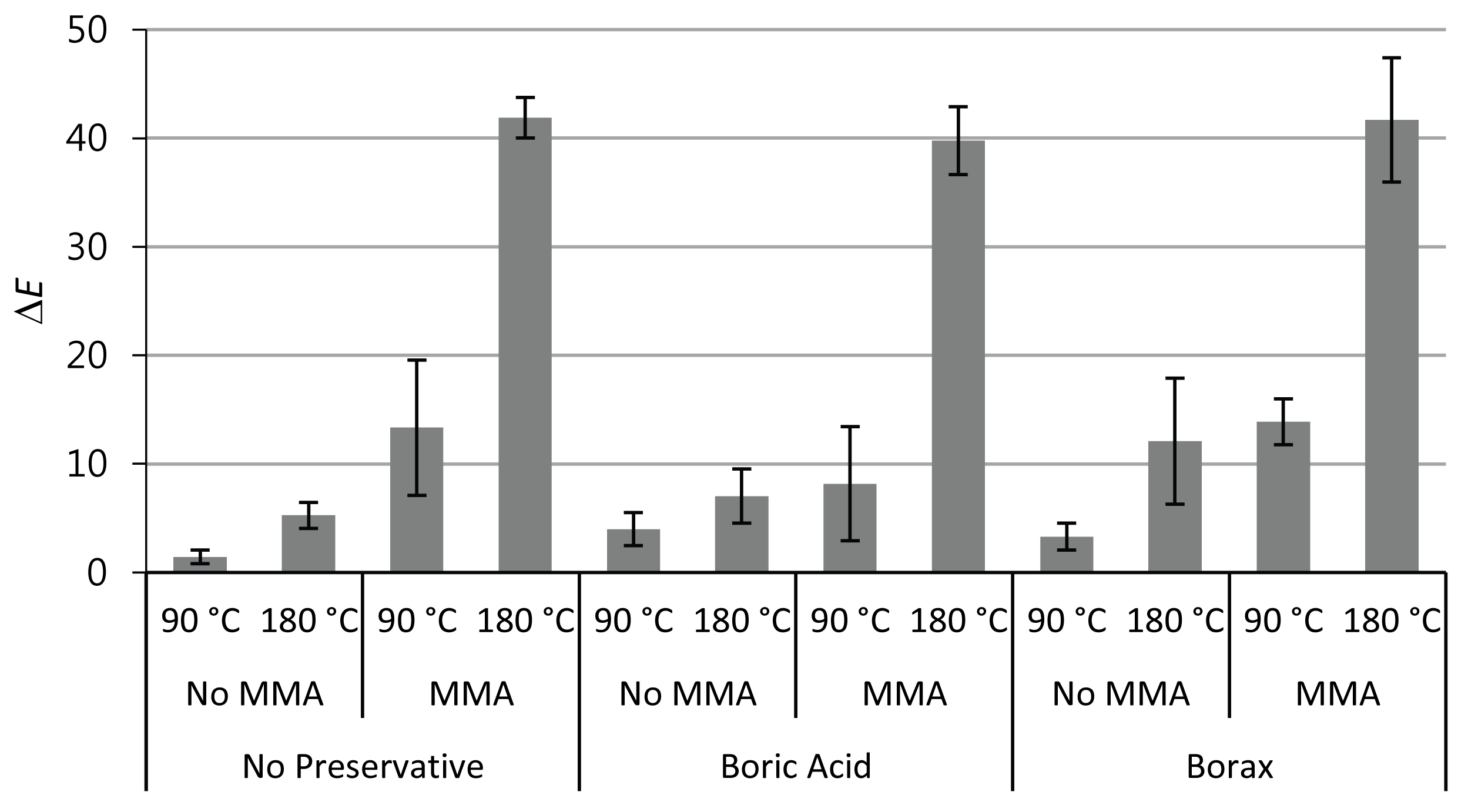
Color changes in wood due to heating could be related to the change or movement of extractives (Mohareb et al., 2010), polysaccharides change (Sahin and Korkut, 2016, Gaff et al., 2019, Cahyono et al., 2020), or related to the formation of carbonyl groups from the oxidation of hydroxyl group in the phenolic components or the formation of quinoid structures from adjacent hydroxyl groups (Wei et al., 2017).
This research showed that boron preservative, MMA and heat treatment generally increased the resistance of red jabon wood from decay fungi as indicated by a decrease in weight loss of the wood (Fig. 8). The analysis of variance and Duncan test at 95% confidence interval showed that weight loss of boron (boric acid and borax) impregnated woods were significantly lower than the control. A similar result was showed by Kartal et al. (2004) that boron treated wood was more resistant to brown-rot fungus Fomitopsis palustris and white-rot fungus Trametes versicolor. Moreover, this research showed that boric acid impregnation resulted more resistant wood against white-rot fungi, Schizophylum commune than that of borax impregnation treatment. In addition, heating at 180 °C improved the resistance to fungi as indicated by a lower weight loss than that of heating at 90 °C. MMA impregnation followed by heating at 180 °C improved the resistance to fungi significantly, while those heated at 90 °C were not significantly different from the control. The lowest weight loss value occurred in red jabon wood that was impregnated with boric acid and MMA followed by heating at 180 °C.
Ground contact durability test of wood was evaluated based on its weight loss. According to Priadi (2011) termites and decay fungi were the main wood-degrading organisms that attack wood in ground contact.
This research revealed that boron impregnation, MMA impregnation or heat treatment improved wood durability that indicated by lower values of weight loss than that of the untreated wood (Fig. 9). The analysis of variance and Duncan test at 95% confidence interval also proved that the weight loss of impregnated red jabon wood with boric acid or borax was significantly lower than the control sample. In addition, MMA impregnated wood also has a prominent smaller weight loss than the wood without MMA impregnation. According to Kartal et al. (2004), MMA could maintain the presence of boron compounds in wood from leaching and become more resistant to the termites of Coptotermes formosanus Shiraki. Besides, according to Hadi et al. (2015), MMA treatment improved the resistance of jabon wood against Coptotermes curvignathus subterranean termites. MMA is not toxic to termites but can inhibit termite attacks on wood.
4. CONCLUSION
Boron impregnation, MMA impregnation as well as heat treatment resulted in dimensional stability and durability improvement of red jabon wood. MMA treatment with heating at 90 °C reduced water absorption and leaching of boron preservative from red jabon wood. Impregnation of boric acid and MMA with a heating temperature of 180 °C increased the dimensional stability of the wood with an ASE value of 81.71%. The hygroscopicity of wood also decreased, which was indicated by water absorption reduction to 43.86%. This treatment also increased the resistance of red jabon wood against decay fungi and subterranean termites.









